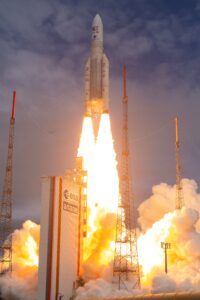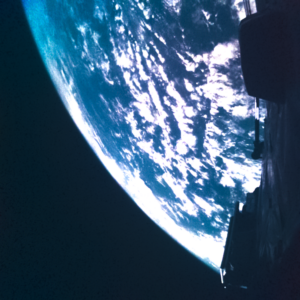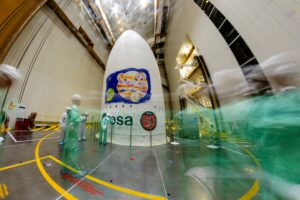JUICE mission with Czech participation is on its way to Jupiter
At 14:14 CEST on 14th April 2023, the European Space Agency’s (ESA) JUICE (Jupiter Icy Moons Explorer) mission with important Czech participation blasted off on the Ariane 5 rocket from the European spaceport in French Guiana. After a successful launch, the spacecraft was separated from the upper stage, sent its first signal and began its long journey to Jupiter and its moons. The solar panels were deployed and the basic subsystems of the spacecraft were tested and found to be working as they should.
At Jupiter in 8 years
JUICE has to perform several gravitational manoeuvres to reach its destination: back to Earth and Moon in August 2024, back to Venus in August 2025 and back to Earth in September 2026. The last gravitational slingshot to Earth in January 2029 will already point the spacecraft directly towards Jupiter, where it will arrive in July 2031.
The preparation of the JUICE mission has been challenging in several aspects. The spacecraft must withstand temperatures ranging from -230 °C to 250 °C and the extremely high radiation around Jupiter. Thus, the spacecraft and scientific instruments must be protected and shielded to operate in this environment. It will take 1 hour 40 minutes for the signal to travel from Earth to the probe and back, so the probe must be able to control itself and is thus equipped with an autonomous navigation system. The mission is also special because the integration of the spacecraft was completed during a challenging period of restrictions associated with the Covid-19 pandemic.

(JUICE launch, credit: ESA – S. Corvaja)
Participation of Czech scientists and companies
Projects and contracts worth 160 million CZK (6,55 million EUR) have been implemented in the Czech Republic. These projects and contracts were funded by the contribution of the Ministry of Education, Youth and Sports (MEYS) to the ESA Science Programme and the PRODEX programme. Important was especially the participation of two teams of Czech scientists from the Institute of Atmospheric Physics of the Czech Academy of Sciences (CAS) and the Astronomical Institute CAS (ASI) in the large international collaboration working on the design and development of one of the scientific instruments of the JUICE mission, the Radio & Plasma Wave Investigation (RPWI). The main task of this instrument is to determine the parameters needed to analyse the generation and propagation of electromagnetic waves in the plasma inside the magnetosphere of Jupiter, in the vicinity of its icy moons and in the magnetosphere of the moon Ganymede. Through direct participation in the development of the scientific instruments, Czech scientists participate in the mission’s science working groups and will have priority access to the obtained data.

(The Earth taken by JUICE onboard camera JMC1, credit: ESA/Juice/JMC)
A number of Czech companies participated in the development and production of not only the scientific instruments, but also the probe itself, i.e. G.L. Electronic provided qualified fitting of electronic components for the electromagnetic wave analyser developed by the scientists from the IAP, the companies Pragoboard and Gatema PCB produced printed circuit boards for the same instrument; The Czech Aerospace Research Centre provided quality control and quality management for the development and testing of the RPWI power supply developed at the ASI. The company BD Sensors-CSRC Space Division supplied the electronic unit for the antenna, which will ensure communication between the JUICE probe and the Earth, company G.L. Electronic supplied the cable harnesses. Frentech Aerospace has supplied mechanisms for the J-MAG magnetometer instrument arm, the Nav Cam navigation camera and the mechanism for the RIME subsurface radar antenna.

(Preparations of Ariane 5 with JUICE for launch, credit: ESA – M. Pédoussaut)
JUICE mission
JUICE is the first of large, „flagship“ missions of ESA´s Science Programme selected in 2012. JUICE will make detailed observations of the giant gaseous planet Jupiter and its three largest moons, Ganymede, Callisto and Europa, which are thought to harbour oceans and possibly life. After its launch, a series of gravity-assist flybys of Earth and Venus will help JUICE to reach the largest planet in our Solar System. JUICE will arrive at Jupiter in 2031 and in 2034, it will become the first spacecraft to orbit a moon other than Earth’s.
ESA is an international organisation dedicated to cooperation in space research and development and applications of space technology. The MEYS’s contribution to ESA’s R&D programmes will reach EUR 14.2 million EUR in 2023.The total Czech contribution to ESA, including the Ministry of Transport, will reach 61.8 million EUR in 2023.